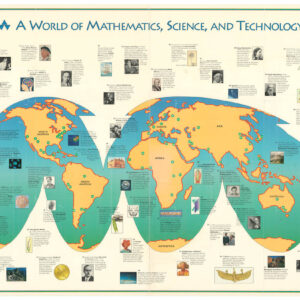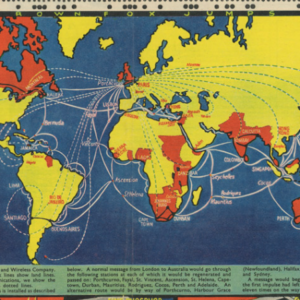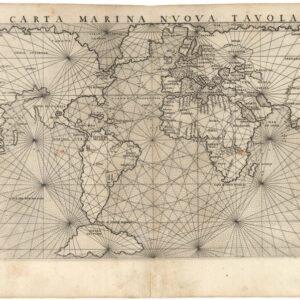Drawing the world in 1812: a Quaker manuscript map blending myth and geography.
Map of the World. 1812.
$1,800
1 in stock
Description
This evocative manuscript map of the world belongs to a category of American manuscript maps from the 18th and 19th centuries known as schoolgirl maps. The origin of this classification is self-explanatory, being products of school children learning the world’s geography. The gendered term reflects both the predominance of surviving examples produced by young women and the fact that they were often part of the curriculum in female academies and finishing schools between about 1790 and 1850. Similarly, they were common practice in Quaker Schools.
Boys certainly studied geography as well, but their education often emphasized practical skills such as arithmetic, surveying, navigation, and bookkeeping. When boys drew maps in school, these tended to be more utilitarian (e.g. field sketches, navigation charts, surveying exercises). Such drawings were usually not saved as art objects. As a result, the survival bias makes it appear that only girls produced such hand-drawn maps.
Many of these maps were hand-drawn or hand-colored on paper, though embroidered maps stitched on silk or linen were also common in the late 18th and early 19th centuries. The motifs were usually maps of the world, the United States, or of the hemispheres, as is the case here. These compositions were most common, as the maps usually were copied from printed atlases or wall maps. Teachers of the era valued them as an assignment because they expanded geographical knowledge, while also exercising penmanship, neatness, artistry, and discipline.
An unusual example
Our schoolgirl map is quite typical in that it depicts the world in two hemispheres, much like atlases of the time. However, it is also unusual in that it combines the use of contemporary places and placenames with ancient and quasi-mythological ones. Thus, we find on the continent both Iowa Town and Quivira (one of the seven mythical cities of gold sought out by Coronado in the 16th century). Of note are the many now antiquated toponyms used, such as New Holland for Australia, the Sandwich Isles for Hawaii, or Hindustan for India. However, the map is also filled with place names one might not expect to be included by a Massachusetts schoolgirl in 1812: the Bab al-Mandeb or Lhasa in Tibet being excellent examples. And finally, we applaud the impressive inclusion and naming of many large rivers across the globe, including in distant Africa and Asia.
The annotations are all written by the same hand, but in varying sizes and fonts. North America is far more densely labeled than Europe, Africa, or Asia, although all continents contain a substantial number of place names. The coloring is exquisite and conveys parts of the geographical information on the map.
There can be no doubt that this is one of the finest examples we have come across, suggesting a dedicated student with a steady hand was behind it. This student is identified at the bottom of the map as one Silvia S. Howland, whom we actually know quite a bit about.
Silvia S. Howland: a Massachusetts Quaker from Dartmouth
Available records identify Silvia S. Howland as a Quaker woman born in Dartmouth, Massachusetts, in 1791. The registers show she was the daughter of Collins Smith and his wife, Hannah Tucker, both of Dartmouth. A family genealogy entry lists “Silvia Smith born the 25th of 4 mo. 1791” as the child of Collins and Hannah Smith. She married Paul Howland (son of Gideon Howland of New Bedford) on March 1, 1809, and used the surname Howland from that point on. Their marriage certificate survives and explicitly dates their ceremony to “the first day of the third month in the year of our Lord one thousand eight hundred and nine”.
She appears repeatedly in Dartmouth Quaker records as a witness at marriages over the following decades, confirming she remained part of the Society of Friends (Quakers) in Massachusetts for decades. A 1838 marriage certificate between George M. Eddy & Elizabeth Davis lists “Sylvia S. Howland” as a witness. These records establish that Howland was a resident of Dartmouth/Bristol County and an active Quaker throughout the 1830s at least.
Aside from these genealogical traces, no published works or biographies of Silvia S. Howland exist. Howland drew our “School map of the world” in 1812 at a time when she would have been 21 and already married for three years. Mrs. Howland was clearly beyond the normal school age, and the creation of this map is probably because she either served as a schoolmistress or was creating an educational tool for her own (or a neighbor’s) children. Quakers placed a high value on education for both sexes and often ran schools—Quaker Women — including married ones — commonly taught younger children in local schools or as private tutors.
Cartographer(s):
Silvia S. Howland (née Smith) was born in Dartmouth, Massachusetts, in 1791, the daughter of Collins Smith and Hannah Tucker, and in 1809 she married Paul Howland of New Bedford. Quaker records show her as an active member of the Society of Friends for decades, frequently appearing as a witness at marriages well into the 1830s. In 1812, at age 21 and already married, she drew the “School map of the world,” likely as a teaching exercise, reflecting the Quaker emphasis on education for both sexes and the common role of women as schoolmistresses or tutors.
Condition Description
Hand-drawn map on thin cardboard. Minor soiling and blemishes.
References
![[Dr. Seuss] This Is Ann….. She Drinks Blood!](https://neatlinemaps.com/wp-content/uploads/2024/05/NL-01354_thumbnail-300x300.jpg)


